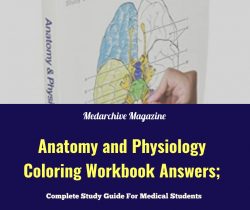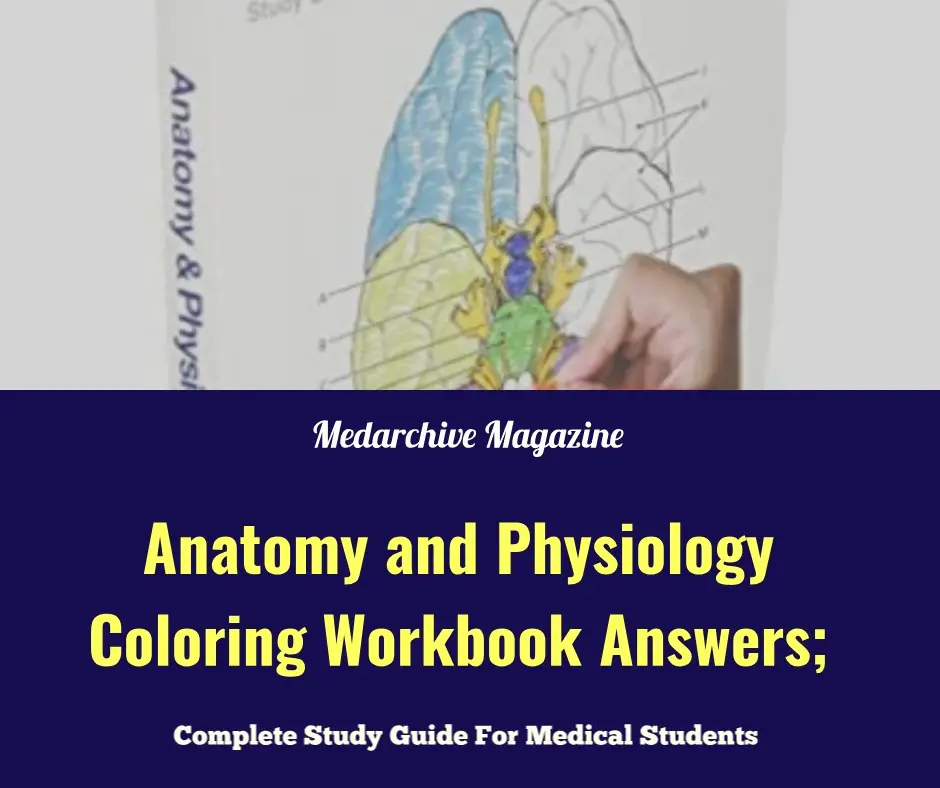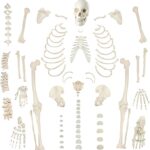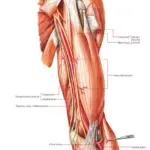This post contains a guide to getting access and using the Anatomy and Physiology Coloring Workbook Answers, a popular medical textbook for medical students in the United States.
Knowing the different parts of the human body is an important part of studying Medicine and Surgery.
This field of study is covered by Anatomy and Physiology which are part of the two major medical school subjects in the pre-clinical years.
In those few years of studying Anatomy and Physiology, medical students often struggle to remember the medical terms for the various body parts and their functions, and which part goes where.
If you want to make your study of Anatomy and Physiology easier and seamless, consider using this workbook to learn about anatomy and physiology.
This Anatomy and Physiology Coloring workbook answers contain answers for all the questions from the book “Anatomy and Physiology Coloring Workbook,” by Elaine N Marieb.
Table of Contents
- About The Book; Anatomy and Physiology Coloring Workbook Answers All Chapters
-
Contents Of The Anatomy and physiology workbook All Chapters
- Anatomy And Physiology Coloring Workbook Answers Chapter 1
- Anatomy and Physiology Coloring Workbook Chapter 2: BASIC CHEMISTRY
- Anatomy and Physiology Coloring Workbook Chapter 3: CELLS AND TISSUES
- Chapter 4: SKIN AND BODY MEMBRANES
- Chapter 5: THE SKELETAL SYSTEM
- Chapter 6: THE MUSCULAR SYSTEM
- Chapter 7: THE NERVOUS SYSTEM
- Chapter 8: SPECIAL SENSES
- Chapter 9: THE ENDOCRINE SYSTEM
- Chapter 10: BLOOD
- Chapter 11: THE CARDIOVASCULAR SYSTEM
- Chapter 12: THE LYMPHATIC SYSTEM AND BODY DEFENSES
- Chapter 13: THE RESPIRATORY SYSTEM
- Chapter 14: THE DIGESTIVE SYSTEM AND BODY METABOLISM
- Chapter 15: THE URINARY SYSTEM
- Chapter 16: THE REPRODUCTIVE SYSTEM
- CHAPTER 17: Answers
-
Contents Of The Anatomy and physiology workbook All Chapters
- How To Use This Book
- Is this Workbook Good For Medical Students Outside the United States?
- How To Get The Anatomy and Physiology Coloring Workbook Online Free
- Conclusion
About The Book; Anatomy and Physiology Coloring Workbook Answers All Chapters

This Human Anatomy and Physiology Coloring Workbook is made up of 16 chapters, each containing questions for each system of the human body.
Each chapter of the book also contains multiple choice and subjective questions meant to be filled by the user.
Also, every chapter contains colored study diagrams for different anatomical structures of the body.
Contents Of The Anatomy and physiology workbook All Chapters
Anatomy And Physiology Coloring Workbook Answers Chapter 1
THE HUMAN BODY: AN ORIENTATION
- An Overview of Anatomy and Physiology
- Levels of Structural Organization
- Maintaining Life
- Homeostasis
- The Language of Anatomy
- At the Clinic
- The Finale: Multiple Choice
Anatomy and Physiology Coloring Workbook Chapter 2: BASIC CHEMISTRY
- Concepts of Matter and Energy
- Composition of Matter
- Molecules, Chemical Bonds, and Chemical Reactions
- Biochemistry: The Composition of Living Matter
- Incredible Journey: A Visualization Exercise for Biochemistry
- At the Clinic
- The Finale: Multiple Choice
Anatomy and Physiology Coloring Workbook Chapter 3: CELLS AND TISSUES
- Cells Overview
- Anatomy of a Generalized Cell
- Cell Physiology
- Body TissuesTissue Repair
- Developmental Aspects of Cells and Tissues
- Incredible Journey: A Visualization Exercise for the Cell
- At the Clinic
- The Finale: Multiple Choice
Chapter 4: SKIN AND BODY MEMBRANES
- Classification of Body Membranes
- Integumentary System (Skin)
- Basic Functions of the Skin
- Basic Structure of the Skin
- Appendages of the Skin
- Homeostatic Imbalances of the Skin
- Developmental Aspects of the Skin and Body Membranes
- Incredible Journey: A Visualization Exercise for the Skin
- At the Clinic
- The Finale: Multiple Choice
Chapter 5: THE SKELETAL SYSTEM
- Bones—An Overview
- Axial Skeleton
- Skull
- Vertebral Column
- Thoracic Cage
- Appendicular Skeleton
- Bone Fractures
- Joints
- Homeostatic Imbalances of Bones and Joints
- Developmental Aspects of the Skeleton
- Incredible Journey: A Visualization Exercise for the Skeletal System
- At the Clinic
- The Finale: Multiple Choice
Also, Check out the best study apps for medical students
Chapter 6: THE MUSCULAR SYSTEM
- Overview of Muscle Tissues
- Microscopic Anatomy of Skeletal Muscle
- Skeletal Muscle Activity
- Muscle Movements, Types, and Names
- Gross Anatomy of the Skeletal Muscles
- Muscles of the Head
- Muscles of the Trunk
- Muscles of the Hip, Thigh, and Leg
- Muscles of the Arm and Forearm
- General Body Muscle Review
- Developmental Aspects of the Muscular System
- Incredible Journey: A Visualization Exercise for the Muscular System
- At the Clinic
- The Finale: Multiple Choice
Chapter 7: THE NERVOUS SYSTEM
- Organization of the Nervous System
- Nervous Tissue—Structure and Function
- Central Nervous System
- Brain
- Protection of the CNS
- Brain Dysfunctions
- Spinal Cord
- Peripheral Nervous System
- Structure of a Nerve
- Cranial Nerves
- Spinal Nerves and Nerve Plexuses
- Autonomic Nervous System (ANS)
- Developmental Aspects of the Nervous System
- Incredible Journey: A Visualization Exercise for the Nervous System
- At the Clinic
- The Finale: Multiple Choice
Chapter 8: SPECIAL SENSES
- The Eye and Vision
- The Ear: Hearing and Balance
- Chemical Senses: Smell and Taste
- Developmental Aspects of the Special Senses
- Incredible Journey: A Visualization Exercise for the Special Senses
- At the Clinic
- The Finale: Multiple Choice
Chapter 9: THE ENDOCRINE SYSTEM
- The Endocrine System and Hormone Function—An Overview
- The Major Endocrine Organs
- Other Hormone-Producing Tissues and Organs
- Developmental Aspects of the Endocrine System
- Incredible Journey: A Visualization Exercise for the Endocrine System
- At the Clinic
- The Finale: Multiple Choice
Chapter 10: BLOOD
- Composition and Functions of Blood
- Hemostasis
- Blood Groups and Transfusions
- Developmental Aspects of Blood
- Incredible Journey: A Visualization Exercise for the Blood
- At the Clinic
- The Finale: Multiple Choice
Chapter 11: THE CARDIOVASCULAR SYSTEM
- The Heart
- Anatomy of the Heart
- Physiology of the Heart
- Blood Vessels
- Microscopic Anatomy of Blood Vessels
- Gross Anatomy of Blood Vessels
- Physiology of Circulation
- Developmental Aspects of the Cardiovascular System
- Incredible Journey: A Visualization Exercise for the Cardiovascular System
- At the Clinic
- The Finale: Multiple Choice
Also, Read; Best Study Resources For Medical Students
Chapter 12: THE LYMPHATIC SYSTEM AND BODY DEFENSES
- The Lymphatic System
- Lymphatic Vessels
- Lymph Nodes and Other Lymphoid Organs
- Body Defenses
- Nonspecific (Innate) Body Defenses
- Specific (Adaptive) Body Defenses: The Immune System
- Disorders of Immunity
- Developmental Aspects of the Lymphatic System and Body Defenses
- Incredible Journey: A Visualization Exercise for the Immune System
- At the Clinic
- The Finale: Multiple Choice
Chapter 13: THE RESPIRATORY SYSTEM
- Functional Anatomy of the Respiratory System
- Respiratory Physiology
- Respiratory Disorders
- Developmental Aspects of the Respiratory System
- Incredible Journey: A Visualization Exercise for the Respiratory System
- At the Clinic
- The Finale: Multiple Choice
Chapter 14: THE DIGESTIVE SYSTEM AND BODY METABOLISM
- Anatomy of the Digestive System
- Physiology of the Digestive System
- Nutrition and Metabolism
- Nutrients Used by Body Cells
- Metabolic Processes
- Developmental Aspects of the Digestive System
- Incredible Journey: A Visualization Exercise for the Digestive System
- At the Clinic
- The Finale: Multiple Choice
Chapter 15: THE URINARY SYSTEM
- Kidneys
- Location and Structure
- Nephrons, Urine Formation, and Control of Blood Composition
- Ureters, Urinary Bladder, and Urethra
- Fluid, Electrolyte, and Acid-Base Balance
- Developmental Aspects of the Urinary System
- Incredible Journey: A Visualization Exercise for the Urinary System
- At the Clinic
- The Finale: Multiple Choice
Chapter 16: THE REPRODUCTIVE SYSTEM
- Anatomy of the Male Reproductive System
- Male Reproductive Functions
- Anatomy of the Female Reproductive System
- Female Reproductive Functions and Cycles
- Mammary Glands
- Survey of Pregnancy and Embryonic Development
- Developmental Aspects of the Reproductive System
- Incredible Journey: A Visualization Exercise for the Reproductive System
- At the Clinic
- The Finale: Multiple Choice
CHAPTER 17: Answers
- Anatomy and Physiology Coloring Workbook Answer Keys
Take a Short quiz on anatomy of the Heart
How To Use This Book
The best way to benefit from this book is by starting on time and studying your anatomy and physiology systematically.
The book has all the systems of the body covered in each of the chapters.
So for every system you read using your anatomy and physiology textbook (Lasts Anatomy and Guyton and Hall respectively), you use the workbook for your personal assessment.
Also, the book can also be used as a revision guide while preparing for your medical school exams in anatomy and physiology.
Where Do You Get The Answers For The Anatomy and Physiology Coloring Workbook?
After solving the questions for each chapter, the answers can be confirmed in the last chapter of the book.
Also, Read; Medical Mnemonics Book For Students: Review
Is this Workbook Good For Medical Students Outside the United States?
Even though this workbook was created especially for medical students in the US, it could also be beneficial to students in Nigerian Medical Schools as well as medical schools in the U.K, Australia, Canada, and other countries.
But for these other medical students, this workbook should be used for general education purposes only.
It should not replace the recommended medical school textbooks in your locality.
How To Get The Anatomy and Physiology Coloring Workbook Online Free
Anatomy and Physiology Coloring Workbook Purchase
Conclusion
Also, Read;





Good read
Thank you for visiting Cruz Staebler